Olympus M.Zuiko Digital ED 12-50mm f/3.5-6.3 EZ
Olympus M.Zuiko Digital ED 12-50mm f/3.5-6.3 EZ Performance
At 12mm and maximum aperture sharpness in the centre of the frame is excellent, but only fairly good towards the edges of the frame. Sharpness reaches good levels across the frame with the lens stopped down to f/5.6 and peak quality across the frame is achieved between here and f/8.Zooming to 27mm results in a decrease in sharpness in the centre of the frame, but the quality towards the edges exceeds good levels from wide open. Peak quality across the frame is achieved at f/5.6 for this focal length.
Finally at 50mm overall sharpness is decreased further just reaching very good levels in the centre at f/6.3. Although this performance is perfectly acceptable, it isn't up to the stellar standard set by other Micro Four Thirds lenses tested to date.
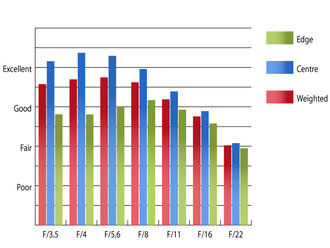 Resolution @ 12mm | 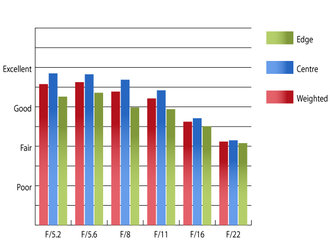 Resolution @ 27mm | |
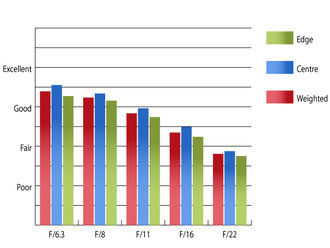 Resolution @ 50mm | How to read our chartsThe blue column represents readings from the centre of the picture frame at the various apertures and the green is from the edges. Averaging them out gives the red weighted column.The scale on the left side is an indication of actual image resolution. The taller the column, the better the lens performance. Simple. For this review, the lens was tested on a Panasonic Lumix DMC-G1 using Imatest. |
At shorter focal lengths, chromatic aberrations are well controlled. At 50mm, fringing of just below 0.75 pixel widths was recorded by Imatest, which shouldn't pose too many issues, unless you are creating very large prints or cropping harshly from near the edges of the frame.
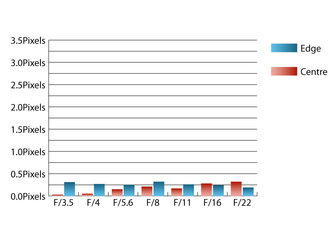 Chromatic aberration @ 12mm | 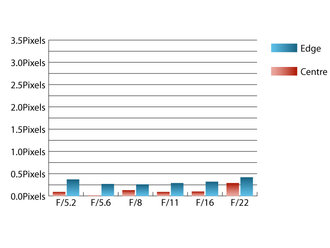 Chromatic aberration @ 27mm | |
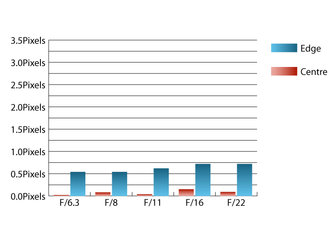 Chromatic aberration @ 50mm | How to read our chartsChromatic aberration is the lens' inability to focus on the sensor or film all colours of visible light at the same point. Severe chromatic aberration gives a noticeable fringing or a halo effect around sharp edges within the picture. It can be cured in software.Apochromatic lenses have special lens elements (aspheric, extra-low dispersion etc) to minimize the problem, hence they usually cost more. For this review, the lens was tested on a Panasonic Lumix DMC-G1 using Imatest. |
Falloff of illumination towards the corners is very well controlled. At 12mm the corners are only 0.86 stops darker than the image centre and at 50mm this level drops to 0.36 stops. At 12mm visually uniform illumination is achieved at f/5.6 and f/8 results in uniform illumination at 50mm.
Distortion is well controlled throughout the zoom range. At 12mm Imatest detected 1.47 % barrel distortion and only 0.352% barrel disrtion at 50mm. These low levels of distortion shouldn't pose too many issues for general photography and the distortion pattern is uniform across the frame, making it relatively straightforward to correct in image editing software afterwards.
Add your message
Login required
Please login here or if you've not registered, you can register here. Registering is safe, quick and free.
Please login here or if you've not registered, you can register here. Registering is safe, quick and free.
photodo Stats
1102 lenses
428 MTF tests
74 in-depth photodo reviews
100+ users join each day
Help the lens community by reviewing or rating a lens today via our lens search
428 MTF tests
74 in-depth photodo reviews
100+ users join each day
Help the lens community by reviewing or rating a lens today via our lens search
Latest Lens Reviews
- Chinon 28mm f/2.8 Vintage Lens Review
- Canon EF 70-200mm f/4L IS II USM Lens Review
- Samyang AF 85mm f/1.4 EF Review
- Sigma 70mm f/2.8 DG Macro Art Review
- Samyang AF 24mm f/2.8 FE Review
- Meike 50mm f/1.7 Review
- Tamron 70-210mm f/4 Di VC USD Review
- Lensbaby Burnside 35mm f/2.8 Review
- Asahi Super Takumar 50mm f/1.4 Review
- Asahi Super-Multi-Coated Takumar 135mm f/3.5 Review
